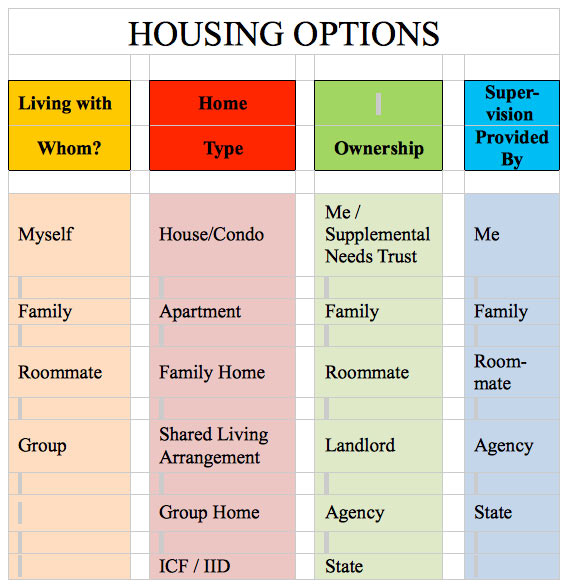![]() For most families, living with their adult child or parent with special needs is the reality. However, the optimal situation for many individuals with special needs would be living elsewhere. Normally, during the transition years of school (ages 14-21), the issue of housing is addressed. A delay in addressing housing, due to an injury or diagnosis happening after the end of the school years, makes the search for housing options even more challenging. Adding to the difficulties of making the appropriate housing choice is the need to find quality support staff and organizations and evaluating the limited subsidized housing options that exist.
For most families, living with their adult child or parent with special needs is the reality. However, the optimal situation for many individuals with special needs would be living elsewhere. Normally, during the transition years of school (ages 14-21), the issue of housing is addressed. A delay in addressing housing, due to an injury or diagnosis happening after the end of the school years, makes the search for housing options even more challenging. Adding to the difficulties of making the appropriate housing choice is the need to find quality support staff and organizations and evaluating the limited subsidized housing options that exist.
The first key point to understand is that unlike health care, there is no government guarantee for housing for those in the special needs community. The primary government support comes through a Medicaid waiver known as the Home and Community-Based Service program. While the program does not directly provide housing, it provides a variety of different kinds of support depending on the type of housing being pursued by the individual.
The other government program is the housing choice voucher program more commonly known as Section 8. This program provides very low income individuals with subsidized housing. Unfortunately, there are a limited number of buildings qualified to accept Section 8 vouchers and it can often take years to obtain a voucher. So while the program exists, the ability to utilize the Section 8 benefit in a desired community is severely impacted by limited supply.
For all families, the challenges of finding optimal or even acceptable housing for their family member with special needs are daunting. Most states provide far less service than is demanded by their populations. This imbalance leads to scarcity and the need for all families to be diligent in seeking what they need.
This article highlights the most common housing options, the characteristics of the individuals best suited to each type of housing, and the challenges most often associated with each living arrangement.
The following charts, adapted from the work of the Housing Opportunity Development Corporation and the Center for Independent Futures, illustrate the many decisions that need to be made as part of the housing evaluation process. Depending on the option selected in one category, the options available in the other categories may become more limited.

The costs related to the various options listed above vary significantly. For an individual living at home, a contribution to the household expenses may be all that is needed to support the living arrangement. On the other end of the spectrum, an individual living in a skilled nursing facility might reasonably expect to pay $10,000 per month for their housing and support expenses.
There are numerous decisions to be made and they can change over time due to the changing needs of the individual and the quality of the experience with the initial model chosen. Most families seek the most independent setting that allows for the greatest level of self-determination. The reality is that for many individuals the most independent choices are not the most appropriate for a variety of different reasons related to their individual needs and challenges
Living alone is most appropriate for higher functioning individuals who will get out into the community on a daily basis. They need to possess adequate decision-making skills and have communication skills. For individuals who need a controlled setting, having their own home or apartment can be beneficial. For many individuals who possess the ability to live alone, the option of living with a roommate or small group is more attractive as it creates a social environment and the ability to share responsibilities and expenses with others
Having a roommate or living with a small group has many advantages to living alone. The ability to share expenses makes this arrangement more affordable. The addition of a roommate or roommates provides added security and support for all the individuals in the home. It also makes it more convenient and cost-effective for a care giver or agency to provide services to multiple people. When pursuing some form of a shared living arrangement, you should allow ample time to find appropriate roommates. The challenges of matching suitable roommates are even more complicated when special needs are involved. These challenges lead to a high likelihood of needing to change the roommate structure at some point in the future. Therefore, joint ownership of a property should be entered into cautiously.
The group home setting is growing in popularity and the format has been migrating in recent years to smaller numbers of people living together with each having their own bedroom. However, in Illinois, among those who are in group homes, over half are in settings with at least seven or eight beds. This is twice the national average for the percentage of people living in what are considered “larger” group homes. While it can be more expensive to serve group homes with fewer residents, the clear preference among families seems to be for homes with only four residents.
Carl LaMell, President of Clearbrook, which provides housing and support for over 300 people across 15 Chicago municipalities, states, “staffing is almost always the differentiating factor in the quality of a residential experience.” Any family seeking community-based housing for their loved one with special needs should investigate the various agencies and service providers in their community to find one that they feel is equipped to provide quality staffing and oversight.
There is a current national trend to eliminate state operated development centers which are still commonly referred to as institutions or institutional settings. In 1977, nearly 150,000 persons with intellectual disabilities lived in state operated centers (Braddock, David. State of the States in Disability Services, 2013). This number dropped significantly to less than 30,000 in 2011 (Braddock, 2013). Today, there are fourteen states in which there are no active state operated development centers. In 2015, Autism Speaks stated that Illinois still has 1,675 individuals in institutional settings. They estimate that it costs Illinois over $200,000 per year per person to provide the housing and care for these individuals. Research suggests that the cost of care is far less, with estimates ranging from half to thirty percent as much, to provide housing and care for individuals in smaller community-based housing options. Illinois and other states face political, financial, and physical resource challenges in migrating the population that would be better served in a less restrictive environment from the institutions to communities.
In Chicago, Misericordia is often praised for the variety of housing options they offer and the quality of care they provide across the various settings. Ironically, Misericordia is at risk of being forced to close some of their buildings if legislation aimed at eliminating all institutional housing is passed in Illinois as their apartment buildings might fall under the institutional classification. Hopefully legislators will work to close facilities where the care is inadequate and allow all types of housing to be available so that families can have as many options as possible for their loved ones with special needs.
As challenging as the current housing landscape appears, there is great interest and momentum building to bring new housing options to market. Many communities are becoming more accepting of group homes in their neighborhoods, not-for-profit organizations are putting more emphasis on providing new housing options and housing supports, and some new developments are being launched that may be able to be replicated in other areas in the country.
One of the most exciting options being planned in the Chicago area is in the far-western suburb of Sugar Grove. The Canopy at Rich Harvest Farms project is being developed by the Giant Steps organization which provides services to the Autism community. The project will encompass a 40-acre campus consisting of permanent living space for 36 adults. It will also include a community center with a commercial kitchen, great room, interactive media area, art therapy rooms, sensory spaces, a fitness facility, office, and conference rooms. Each participant will also have access to a career college encompassing vocational training programs and community based learning initiatives that will prepare them to choose the life path that best fits their desires and skills. Like many new initiatives in the special needs community, the biggest hurdle facing Giant Steps is raising the funds to build and sustain this community.
The most recent Federal development is the March 2015 award of $150 million by the U.S. Department of Housing and Urban Development (HUD) to twenty-five state agencies that will provide housing and housing supports to the very poor who are at risk of being institutionalized or becoming homeless. The award is anticipated to provide housing for 4,600 families. Despite this step in the right direction, there are hundreds of thousands more who wish they had better housing options.
Connecting with community support organizations, advocating for housing, and thinking creatively with similarly motivated families remain among the best strategies for families seeking housing options for their family member with special needs. Like other aspects of life in the special needs community, the challenges are great but with hope and the relentless pursuit of goals, positive outcomes are possible.
Oak Wealth Advisors works with families who are seeking housing options and evaluating their finances for the options they find most attractive. We have contacts at numerous agencies and organizations and take pride in helping families secure solutions that meet all of their family’s objectives.
This update is intended for the use of Oak Wealth Advisors LLC clients. This update should not be viewed as legal advice, tax advice, personalized investment advice, or financial planning advice from Oak Wealth Advisors LLC. To the extent that a reader has any questions regarding the applicability of the information discussed above to their individual situation, they are encouraged to consult Oak Wealth Advisors LLC.




